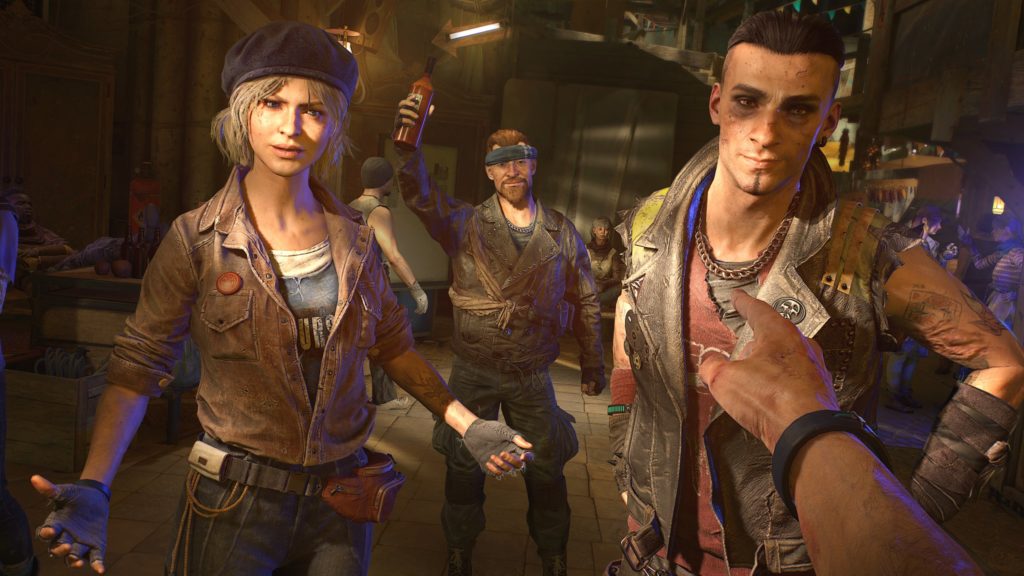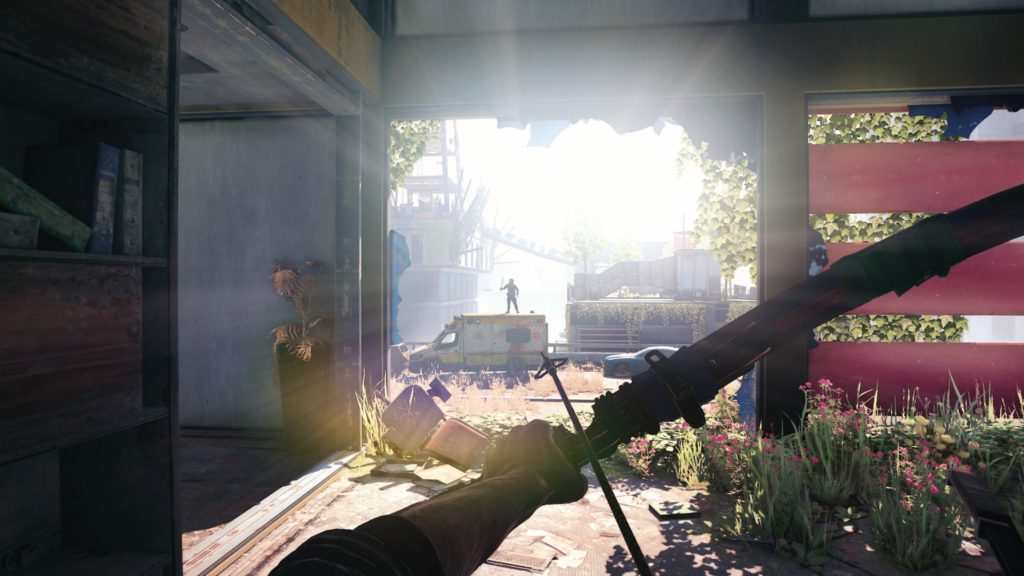Vaultingly ambitious, Techland’s second instalment of open-world, melee and parkour-based zombie-warfare offers a huge amount of satisfaction.
Whatever your views on anti-vaxxers, our real-life streets aren’t yet being stalked by zombies. However, we do all now have experience of a viral outbreak, which renders the arrival of Dying Light 2: Stay Human somewhat apposite. Developer Techland’s second instalment of its much-loved open-world zombie franchise charts a world that has spent 15 years coping with a viral outbreak and, unsurprisingly, it’s a pretty bleak and scary place.
Paradoxically, for a gamer, because it’s a Dying Light game, that world also happens to be a comfortable and inviting place in which to hang out. Like its predecessor, it’s a veritable garden of zombie-eviscerating delights. Thanks in no small part to the skills of the character you play, Aiden Caldwell: not only is he masterful at parkour, but he’s blessed with a gloriously smooth and accurate melee combat system, that – depending on the weapon you have – can decapitate a zombie with a single, satisfying sweep if you get your timing right. The parkour and melee combat systems featured in the first Dying Light, but this time around, Techland has honed them further, to near-perfection.
A branching storyline that sometimes cheats
Story-wise, Dying Light 2 occasionally fails to avoid cliché-traps, and in its early stages sends you off on a few wild goose chases more in order to introduce new systems than to advance the plot, but it also puts you on the spot at various points, forcing you to make decisions that send you off in different narrative directions.
Aiden is on a quest to find his missing sister Mia – he’s plagued with flashbacks to their shared childhood, when they were experimented on in a facility run by the GRE, the medical-cum-military organisation tasked with finding a cure for the virus, which ended up being hounded into oblivion when it was blamed for further outbreaks.
Starting in the countryside, Aiden learns that he needs to go to a bar called the Fish Eye in the walled town of Villedor, if he is to pick up Mia’s trail. But even before he makes it to the city, he is bitten by a zombie and thereby infected with the virus, acquires what is apparently the last GRE access key in existence (which makes him a marked man for the rest of the game) and must take on a bunch of Renegades, one of the game’s three human factions along with Peace Keepers and Survivors.

Arriving in Old Villedor, he’s nearly hanged because he doesn’t have a biomarker (a wristband which changes colour when its wearer is about to turn into a zombie). But a character called Hakon rescues him and fits him with a biomarker. Now, Aiden’s mission is to get from Old Villedor to Central Loop, the city area that contains the Fish Eye. That’s easier said than done, since the Peace Keepers have closed the Metro tunnel leading out of Old Villedor, after their leader, Lucas, was murdered. The new leader Aitor, says he will let Aiden through if he can find Lucas’s murderer.
To that end, Aiden embarks on a series of missions for the Survivors, with a sub-text of investigating whether they were responsible for Lucas’s death. At first, Dying Light 2’s fondness for double-dealing and treacherous characters, as well as its need to introduce you to various systems (such as Aiden’s ability to fix power-providing windmills and its showcasing of different types of boss-like zombies), along with junctures when you must choose between two paths, leads to a somewhat disjointed narrative experience.
The voice-acting is also pretty patchy, and the dialogue distinctly variable, but once Aiden makes it to Central Loop, the story settles down, becoming much more coherent and shaking off the sense that it is cheating on you by introducing twists that render what you’ve just been doing irrelevant.
A dizzying array of systems
You could argue, however, that Dying Light 2 isn’t really about the story – which Techland accurately said takes about 20 hours to finish (although it commendably leaves some spaces for general activities and side-missions, which veer wildly from soap-operatic missions, via often amusing quirkiness, to tedious fetching and carrying).
Techland also said – causing a rather unseemly outcry among those who would just as happily deride a 15-hour single-player game for offering poor value for money – that completing everything in Dying Light 2 (and presumably all the DLC it has yet to add) would take 500 hours. Whether that’s true remains to be seen, but there’s no doubt that Dying Light 2 is the most ambitious open-world zombie-eviscerating playground ever created.

That playground is underpinned by a huge number of systems – so many that the fact they mesh so coherently is quite an achievement. For a start, it’s a full-blown RPG, with skill trees for melee combat and parkour; Aiden can increase his underlying stats for health and stamina by finding Inhibitors, which also feed into the amount of time he can survive at night without finding UV light or taking immunity boosters in order to avoid turning into a zombie himself.
There are various infrastructure elements which he can get up and running via puzzle-type activities and parkour, including electricity substations, Metro stations, windmills and water towers, many of which he can then allocate to a particular faction, which in turn alters the environment. Peace Keepers, for example, will turn nearby parked cars into traps that attract zombies with alarms then explode, while Survivors will add street-level parkour crash-pads. Techland’s pre-launch claims that that mechanism allows you to reshape Villedor amounts to a bit of a stretch, but it adds to your post-story immersion in the city.
The game’s day-night cycle looms large, too: various types of activity, such as clearing out Infected hollows and GRE facilities, are best undergone at night since, by day, they are full of resting zombies. There’s a full crafting engine – cutely, you need to collect Infected Trophies by killing the more exotic zombies in order to upgrade crucial craftable items like health packs and Molotov cocktails. To upgrade the equipment Aiden inherits from the defunct Nightrunners faction, such as his excellent. manoeuvrable paraglider and a zombie-paralysing UV torch, you need to find the military tech dropped by the GRE years before onto the most inaccessible rooftops.

As in the first game, zombies will chase you if they spot you at street level after dark – you can evade them by hiding or getting to a zone lit by UV light. There are vast amounts of activities to pursue, along with random encounters, and if you set out to unlock all the infrastructure, you will eventually end up feeling that you have reshaped the city. That mechanism fails to kick in while you’re still working through the story, though.
Great parkour and melee combat
But the key elements that make Dying Light 2 deeply enjoyable and very satisfying are its parkour and melee combat engines – as was the case for the first game. Both have been refined to a very advanced, smooth state, and the parkour given an added twist via a grapple-hook, whose realistic physics make it harder to use than you might anticipate.
As Aiden levels up and acquires new combat moves – some of which are great, and all of which are at the very least stylish — he becomes a veritable zombie-evisceration machine, able to take on hordes with confidence (as long as he has the right tools in terms of attacking and defensive items like improvised grenades and fast-application military health packs).
That, in truth, is what Dying Light 2 is all about – along with its surprisingly plausible portrayal of a city that has spent 15 years living with a deadly virus. Quite simply, if you love laying waste to zombies, then you should also love Dying Light 2: Stay Human. Its open world may be a complex, ever-changing place but deep down it’s still just a very fine zombie game.
